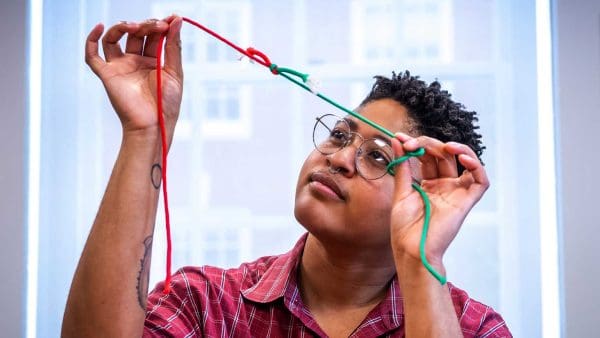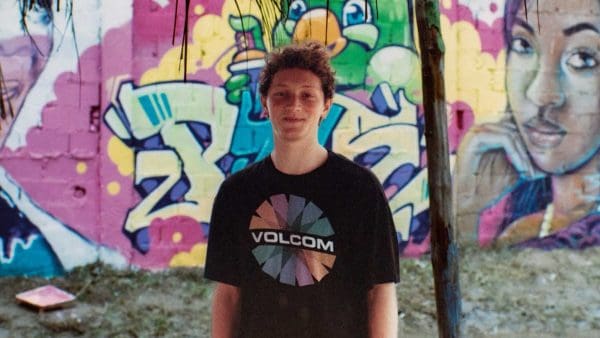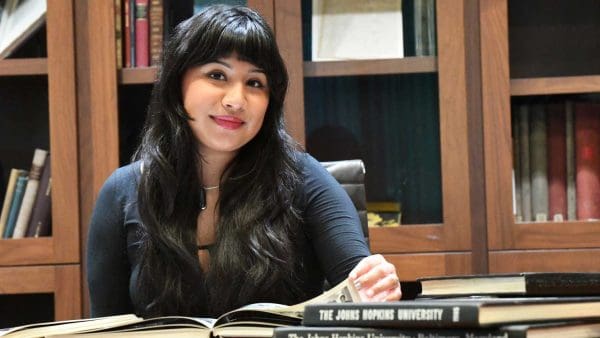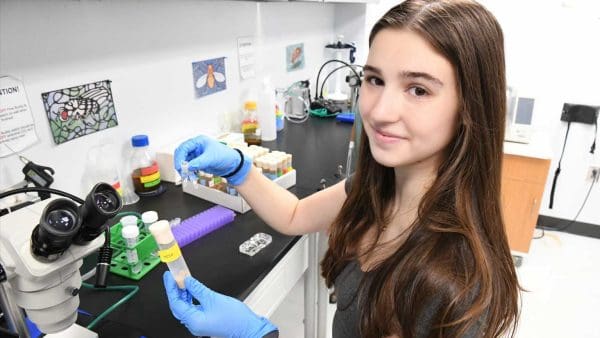Oil and Water

Mollie Cueva-Dabkoski ’17
Last summer Mollie Cueva-Dabkoski ’17 found herself in the Ecuadorian Amazon rainforest canoeing down the Aguarico River toward a small village inhabited by the indigenous Cofán people. There she would spend the next five weeks conducting qualitative research, interviewing the residents about their lives and their thoughts on the oil industry, long active in the area. “It was probably one of the most challenging experiences I’ve ever had,” she says of her time spent beyond the reach of roads (but not beyond the reach of clouds of mosquitoes).
Cueva-Dabkoski was born in Ecuador and raised in San Francisco, where she says her mother instilled within her a deep interest in social justice. “In middle school, I started to hear about oil contamination in the Amazon largely and disproportionally impacting indigenous people and I was horror-stricken,” Cueva-Dabkoski says. “It’s always been a dream to focus on this problem.”
She’s preparing for such work by double majoring in public health studies and sociology with a minor in Latin American studies, while also working as a research assistant in the Department of Sociology’s Poverty and Inequality Research Lab.
Ecuador is among the largest oil producers in South America, and oil accounts for a third of the nation’s export income. But extracting this resource has been problematic, contaminating forests and rivers and leading to increased cancer risks for many. The aim of her project was to gain a better understanding of the socioeconomic consequences the oil industry has had for subsistence farmers.
“By understanding opinions about oil, you get a better sense of how indigenous people are interacting with this industry, how it is impacting them, and how we can create policies that support those who are most vulnerable to these large corporations,” she says.
She ended up interviewing more than 40 people, and while the transcribing and analysis of more than 70 hours of recorded conversations is ongoing, one surprise emerged: While she expected there to be near-universal condemnation of the oil industry, many villagers saw economic benefits to the industry’s presence.
Suffice it to say, the issue is complicated. Cueva-Dabkoski turned her research into a senior thesis and also plans to return to the Cofán forests. “It was an incredible privilege to move to the Amazon for nearly a month and half,” she says. “I made connections with this community, and I’m working to help it have longevity and sustainability. This work is important to me as an aspiring sociologist but also as an Ecuadorian-American. My insider-outsider status pushes me to return to Ecuador.”
Photos courtesy of Mollie Cueva-Dabkoski ’17
Emotional Rescue

Charltien Long ’17
Imagine losing a loved one who is sitting right in front of you.
Individuals who suffer a right-hemisphere stroke or develop the neurodegenerative disease frontotemporal dementia (FTD) can experience debilitating behavioral changes, diminished motor skills, and a marked reduction in social interaction skills. It can also negatively impact their quality of life—and that of their caregivers. Such patients, for example, may no longer understand the emotional cues within a conversation—a speaker’s tone of voice or facial expressions. Consequently, they often can’t tell when someone is happy or sad or angry.
“Maybe you were married to someone for 25 or 30 years, and one day they have a stroke, and they are just not the same person afterwards,” says neuroscience major Charltien Long ’17. “The emotional closeness between you is gone, and it’s very hard to connect or communicate in a meaningful way. It’s like they are lost to you.”
Working under Johns Hopkins neurologist Argye Hillis, MD, in the School of Medicine’s Stroke Cognitive Outcome and Recovery Lab, Long focused on finding ways to bridge this distressing divide. Long had learned from previous training at the lab of Sophia Vinogradov, MD, at the University of California, San Francisco, that schizophrenia patients experiencing a similar loss of empathetic abilities have had success with a computer-based training system that helps them learn the norms of social and emotional interaction. Could such a brain-training approach benefit his target population as well?
Long devised a clinical study wherein 10 patients with FTD or who had suffered a right-hemisphere stroke performed about 30 hours of such training over a span of a few weeks to a few months. The flash-card-like training uses either a laptop or an iPad to train patients with various social and emotional skills. One screen describes a series of human interactions and then, on the following screen, patients answer multiple-choice questions about the emotional state of the participants: who was sad, proud, angry, etc. Other exercises such as facial expression training work similarly: A face is shown and then on a subsequent screen the participants choose the emotion it was expressing.
Analysis of the results is still ongoing, but Long says one of the valuable lessons regarding computer-based training for stroke patients is the need to adapt and optimize the test for an audience that can have vision or motor skill impairments. (Some participants had difficulty operating a mouse effectively, for example.) He also relished how the project got him out of the classroom to confront real-world issues.
“When we talk about neuroscience at Hopkins, much of our education is focused on cells and molecules,” Long says. “On the other hand, I think what people find most meaningful in life is social connection and our ability to empathize with others and to care about the world.”
Aid in the Airwaves

Michelle Kihara ’17
The Nyarugusu refugee camp in western Tanzania was built in the 1990s to house 60,000 people fleeing armed conflict in the region. By 2015, it housed well over 100,000 people, mostly Burundians and Congolese. “When you have that level of overcrowding in a refugee setting, various health issues come up, such as cholera and different infectious diseases,” says public health major Michelle Kihara ’17.
As a native of East Africa herself (she’s from neighboring Kenya), Kihara wanted to learn more about the public health challenges within the camp and how they were being addressed. And she discovered a fascinating way to do so from far-away Baltimore. She listened to some 40 hours of archived radio programming that had been broadcast into the camp, transcribing it and then translating it from Swahili to English for content analysis.
“One thing they did very well was to draw on different levels of communication,” Kihara says. “They might have health experts speaking for one portion and then they would have a play with characters addressing a topic like HIV in a very relatable way.”
She also learned how they addressed the emerging threat of Ebola and delicately handled the subject of traditional healing methods (not always helpful but believed by many to be). The work so absorbed her that for her senior thesis, she continued to research the mass media’s role in addressing health issues, particularly in populations with limited resources.
“When I did this project I was debating between studying public health or neuroscience,” she says. “This project really just focused my trajectory because it was somewhere very close to where I’m from in East Africa and it exposed me to a lot of health issues that I might not have known about. It really set the tone for what I’m doing now.”
And what she’ll be doing in the fall is heading over to the Bloomberg School of Public Health to pursue a master’s degree.
Photos courtesy of Michelle Kihara ’17
Korean Conflict

Sang June Oh ’17
The future of historical documents can sometimes be the subject of present-day conflict. History major Sang June Oh ’18 learned this curious lesson firsthand while co-authoring an article in the American Historical Association’s magazine Perspectives on History last fall on a 2015 legal battle over the fate of a rare cache of Korean-American documents.
The Korean native was interning at the association over the summer when he spied “Korean-American papers” on a list of topics for upcoming magazine articles. “I was pleasantly surprised to find that the association readily covered East Asian history,” he says. “People tend to place greater importance on Chinese and Japanese rather than Korean history.”
At issue was a trove of historic documents and photographs related to the Los Angeles-based Korean National Association of North America (KNA) during the early years of the 20th century. The long-neglected materials had been found in the group’s disused headquarters building, where some of it was decaying. The KNA Memorial Foundation, the group now looking after the building, wanted to send the materials to Korea for safekeeping—much to the dismay of some local Korean community groups and academics who went to court to block the relocation. They wanted the invaluable slice of Korean-American history to remain in the United States for easy access.
Oh interviewed people on both sides of the conflict for the article, some of whom requested speaking with a Korean. Ultimately, a settlement was reached wherein the materials will be digitized and then loaned to Korea until a suitable facility to house them in California is developed.
“If I learned anything, it’s that politics plays into practically everything,” Oh says. “But, really, what was more interesting was getting acquainted with Korean-American history.”













